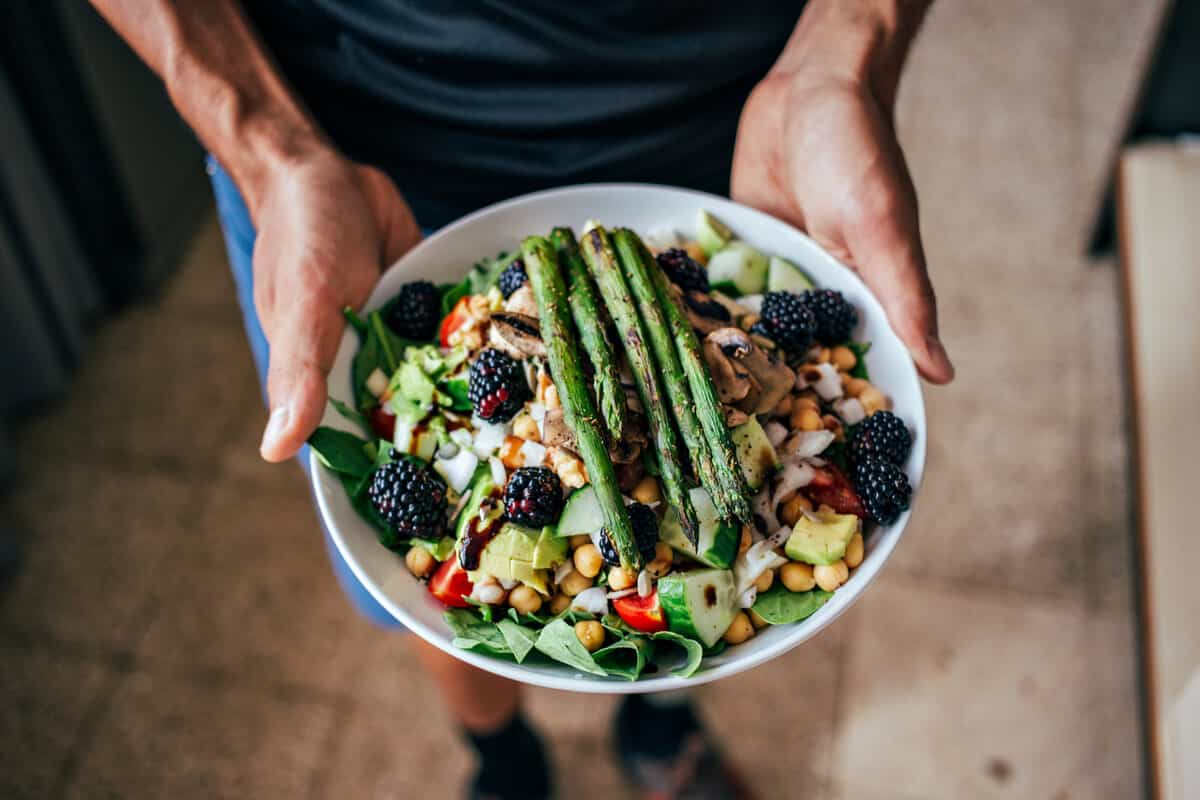
The Candida diet promotes the consumption of non-starchy vegetables, lean protein, healthy fats, and gluten-free grains.
What is Candida?
Candida is a genus of yeast that occurs naturally on the skin and in body cavities, including the oral cavity, digestive tract, and genitourinary tracts. The most common Candida yeast is the species Candida albicans. (7) Although it’s normal for Candida to exist on the skin and in the body in small amounts, certain factors such as stress, infection, or antibiotic use may disrupt the healthy balance of your intestinal flora, leading to yeast overgrowth. Candida overgrowth is also commonly referred to as candidiasis. (20) Symptoms of Candida overgrowth include:- Fatigue (5)
- Frequent yeast infections (10)
- Joint pain (13)
- Skin conditions (e.g., psoriasis) (2)
- White patches on the tongue, inside of the mouth, or throat (thrush) (6)
Contributing factors
It’s believed that a diet high in sugar and refined carbohydrates, such as white bread and sugar-sweetened beverages, is one of the primary contributors to candida overgrowth. Carbohydrates are the preferred energy source for yeast, and as a result, eating a diet rich in sugar and refined carbohydrates can provide the perfect environment for Candida overgrowth. (26) Specific populations also have an increased risk of developing candidiasis, including individuals with a weakened immune system, type 2 diabetics, and patients using antibiotics. (6)Did you know? There are over 100 types of Candida that can be found in the body; however, only a few can lead to infection if an overgrowth occurs. (9)
What is the Candida diet?
Some integrative healthcare practitioners recommend following a Candida diet to address the symptoms and reverse yeast overgrowth. Although research linking the effects of dietary modification and improvements in Candida is limited, preliminary research suggests that eliminating certain foods, such as milk, sugar-containing foods, and processed and fatty meats, may be beneficial. (1)(23) Results of a 2018 study demonstrated that individuals who adhered to recommended dietary modifications during and after treatment with antifungals experienced better outcomes than those who didn’t modify their diet. (23) The Candida diet involves eliminating certain foods believed to contribute to increased inflammation in the gut that can lead to Candida overgrowth. The diet promotes the intake of lean protein, healthy fats, and non-starchy vegetables. Proponents of the diet suggest eliminating certain foods can reduce inflammation and restore balance in the gut microbiome. (27) If you’re struggling with Candida or a condition associated with Candida yeast overgrowth, your practitioner may advise you to adhere to the Candida diet guidelines. It’s important to note that further research is needed to definitively declare whether following a specific diet can help treat Candida overgrowth.Foods to eat on the Candida diet
The Candida diet encourages the intake of low-sugar, gluten-free, and anti-inflammatory foods, commonly found in the paleo and Mediterranean diets, including:- Certain dairy products: butter, ghee (clarified butter), plain yogurt, and kefir (probiotic yogurt beverage)
- Fermented foods: kimchi, sauerkraut
- Fish: herring, mackerel, salmon, sardines
- Healthy oils: avocado oil, coconut oil, extra-virgin olive oil, sesame oil
- Lean proteins: eggs, turkey, chicken (white meat)
- Low-mold nuts and seeds: almonds, flaxseed, hazelnuts, hemp seeds, sunflower seeds
- Low-sugar fruits (limited to no more than one to two servings per day): avocados, berries, lemon, lime, tomatoes
- Non-starchy vegetables: artichokes, asparagus, broccoli, cucumber, eggplant, garlic, leafy greens, onions
- No-sugar sweeteners: erythritol, stevia, xylitol
- Whole grains: buckwheat, brown rice, millet, oats, quinoa, teff (23)(27)

Healthy fats, such as avocados and olive oil, are encouraged on the Candida diet.
Foods to avoid on the Candida diet
The Candida diet recommends that the following foods be avoided:- Alcoholic beverages
- Condiments: barbecue sauce, horseradish, ketchup, mayonnaise, soy sauce, vinegar
- High-mold cheeses: yellow cheese, cheese spreads, bleu, gorgonzola
- High-mold nuts: cashews, peanuts, pistachios
- High-sugar fruits and juices: apples, bananas, cherries, dried fruit, grapes, oranges, pears, watermelon
- Milk and flavored yogurt
- Processed meats: bacon, ham, jerky, salami, sausage
- Processed oils: canola oil, soybean oil, sunflower oil
- Red and dark meat: beef, poultry (dark meat), lamb, pork
- Starchy foods: pasta, potatoes, wheat flour, white rice
- Sugar and sugar substitutes: agave, aspartame, cane sugar, corn syrup, honey, maple syrup, molasses, and table sugar
- Sugar-sweetened foods and beverages: candy, desserts, jam, soda, sweetened tea (23)(27)
Supplements to consider for Candida overgrowth
In addition to making dietary modifications, some supplements or antifungals may be recommended by your practitioner to help your body combat Candida overgrowth. (18) Although much of the research is performed in vitro, current evidence suggests that the supplements outlined below have the potential to be beneficial for individuals struggling with Candida.
Probiotics may be useful in the battle against Candida by interfering with the growth of the yeast in your gut.
Probiotics
Probiotics are beneficial live microorganisms (e.g., bacteria, yeasts) that promote a balance between the good and bad bacteria that live in the gut. Probiotics are found in several foods, including yogurt and fermented foods (e.g., kimchi, sauerkraut, kombucha), and are also widely available in supplement form. (19) Probiotics have been shown to be an effective alternative to prescription antifungals that are commonly used to address Candida infection. Several studies have indicated that probiotics, particularly Lactobacilli strains, may suppress Candida growth. (18) One 12-week study in older adults demonstrated that subjects who took lozenges containing two strains of the probiotic Lactobacillus reuteri had a significant reduction in the number of Candida yeasts in their mouths compared to placebo. (14) Furthermore, probiotics may be useful in alleviating signs and symptoms and reducing the incidence of Candida infection in critically ill patients. (18)Caprylic acid
Caprylic acid is a medium-chain fatty acid naturally found in coconut oil and mammalian breast milk. It’s theorized that caprylic acid, which possesses antifungal properties, helps breakdown Candida by penetrating its cell membranes. (25) A 2011 review of research studies found that caprylic acid was associated with reduced symptoms of Candida. In fact, it was found to be a superior and more cost-effective therapy than some prescription antifungals. (22) Another in vitro study determined that coconut oil might be helpful for Candida infections, particularly for drug-resistant species of Candida. These effects are believed to be attributed to the caprylic acid found in coconut oil. (21)Oregano oil
As a potent antifungal, oregano oil (Origanum vulgare) may be used to address Candida infections. (11) The antifungal effects of oregano oil are attributed to three phenolic derivatives—carvacrol, thymol, and eugenol. (17)(24) Terpenoid phenols, like those found in oregano oil, have been shown to be effective in inhibiting the growth of several strains of Candida, including C. albicans, C. glabrata, and C. parapsilosis. (24) In in vitro studies, oregano oil has been shown to inhibit the growth of Candida yeast cells completely. (17) According to one study comparing the effects of oregano oil versus antifungal drugs in 30 strains of C. albicans isolated from a vaginal swab, oregano oil was shown to be more effective than clotrimazole, an antifungal medication, at damaging the cell wall and membranes of the Candida yeast. (3)Grapefruit seed extract
Research is limited; however, grapefruit seed extract, the aqueous extract of dried grapefruit seed, has been shown to possess antifungal activity, which can be used to target Candida overgrowth. (15) Grapefruit seed extract attacks fungal cells by inducing apoptosis, causing cells to die off. (4)The bottom line
More research is needed to better understand the link between diet and Candida; however, preliminary studies and some experts recommend restricting certain foods, particularly high-carbohydrate and processed foods, to alleviate symptoms associated with yeast overgrowth. Furthermore, certain supplements, including probiotics, caprylic acid, oregano oil, and grapefruit seed extract, may be used to target Candida overgrowth. If you are experiencing symptoms of candida overgrowth, ask your integrative healthcare practitioner if following the Candida diet or using supplements may be right for you.Help more patients.
right in your Fullscript account!
New to Fullscript? Sign up now.
- Abu-Elteen, K. H. (2005). The influence of dietary carbohydrates on in vitro adherence of fourCandidaspecies to human buccal epithelial cells. Microbial Ecology in Health and Disease, 17(3), 156–162.
- Armstrong, A. W., Bukhalo, M., & Blauvelt, A. (2016). A clinician’s guide to the diagnosis and treatment of candidiasis in patients with psoriasis. American Journal of Clinical Dermatology, 17(4), 329–336.
- Bona, E., Cantamessa, S., Pavan, M., Novello, G., Massa, N., Rocchetti, A., Berta, G., & Gamalero, E. (2016). Sensitivity of Candida albicans to essential oils: Are they an alternative to antifungal agents? Journal of Applied Microbiology, 121(6), 1530–1545.
- Cao, S., Xu, W., Zhang, N., Wang, Y., Luo, Y. B., He, X., & Huang, K. (2012). A mitochondria-dependent pathway mediates the apoptosis of GSE-Induced yeast. PLoS ONE, 7(3), e32943.
- Cater, R. E. (1995). Chronic intestinal candidiasis as a possible etiological factor in the chronic fatigue syndrome. Medical Hypotheses, 44(6), 507–515.
- Centers for Disease Control and Prevention. (2020). Candida infections of the mouth, throat, and esophagus. https://www.cdc.gov/candidiasis/about/index.html
- Centers for Disease Control and Prevention. (2020a). Candidiasis. https://www.cdc.gov/candidiasis/about/index.html
- Centers for Disease Control and Prevention. (2020b). Diagnosis and Testing. https://www.cdc.gov/candidiasis/signs-symptoms/index.html
- Centers for Disease Control and Prevention. (2020c). Where invasive candidiasis comes from. https://www.cdc.gov/candidiasis/about/index.html
- Centers for Disease Control and Prevention. (2021). About invasive candidiasis. https://www.cdc.gov/candidiasis/index.html
- Cleff, M. B., Meinerz, A. R., Xavier, M., Schuch, L. F., Meireles, M. C. A., Rodrigues, M. R. A., & Mello, J. R. B. (2010). In vitro activity of origanum vulgare essential oil against candida species. Brazilian Journal of Microbiology, 41(1), 116–123.
- de Oliveira Santos, G. C., Vasconcelos, C.C., Lopes, A.J.O., de Sousa Cartágenes, M. S., Filho, A.K.D.B., do Nascimento, F.R.F., Ramos, R. M., Pires, E.R.R.B., de Andrade, M.S., Rocha, F.M.G., & de Andrade Monteiro, C. (2018). Candida infections and therapeutic strategies: Mechanisms of action for traditional and alternative agents. Frontiers in Microbiology, 9, 1351.
- Gamaletsou, M.N., Rammaert, B., Bueno, M.A., Sipsas, N.V., Moriyama, B., Kontoyiannis, D.P., Roilides, E., Zeller, V., Taj-Aldeen, S.J., Miller, A. O., Petraitiene, R., Lortholary, O., & Walsh, T. J. (2015). Candida arthritis: Analysis of 112 pediatric and adult cases. Open Forum Infectious Diseases, 3(1), ofv207.
- Kraft-Bodi, E., Jørgensen, M. R., Keller, M. K., Kragelund, C., & Twetman, S. (2015). Effect of probiotic bacteria on oral candida in frail elderly. Journal of Dental Research, 94(9_suppl), 181S-186S.
- Krajewska-Kułak, E., Lukaszuk, C., & Niczyporuk, W. (2001). Effects of 33% grapefruit extract on the growth of the yeast–like fungi, dermatopytes and moulds. Wiad Parazytol, 47(4), 845–849.
- Kumamoto, C. A. (2011). Inflammation and gastrointestinal Candida colonization. Current Opinion in Microbiology, 14(4), 386–391.
- Manohar, V., Ingram, C., Gray, J., Talpur, N. A., Echard, B. W., Bagchi, D., & Preuss, H. G. (2001). Antifungal activities of origanum oil against Candida albicans. Molecular and Cellular Biochemistry, 228(1/2), 111–117.
- Matsubara, V. H., Bandara, H. M. H. N., Mayer, M. P. A., & Samaranayake, L. P. (2016). Probiotics as antifungals in mucosal candidiasis. Clin Infect Dis, 62(9), 1143–1153.
- National Institutes of Health. (2020). Probiotics. Office of Dietary Supplements. https://ods.od.nih.gov/factsheets/Probiotics-HealthProfessional/
- Nobile, C. J., & Johnson, A. D. (2015). Candida albicansBiofilms and human disease. Annual Review of Microbiology, 69(1), 71–92.
- Ogbolu, D. O., Oni, A. A., Daini, O. A., & Oloko, A. P. (2007). In vitro antimicrobial properties of coconut oil onCandidaSpecies in Ibadan, Nigeria. Journal of Medicinal Food, 10(2), 384–387.
- Omura, Y., O’Young, B., Jones, M., Pallos, A., Duvvi, H., & Shimotsuura, Y. (2011). Caprylic acid in the effective treatment of intractable medical problems of frequent urination, incontinence, chronic upper respiratory infection, root canalled tooth infection, ALS, etc., caused by asbestos & mixed infections of candida albicans, helicobacter pylori & cytomegalovirus with or without other microorganisms & mercury. Acupuncture & Electro-Therapeutics Research, 36(1), 19–64.
- Otašević, S., Momčilović, S., Petrović, M., Radulović, O., Stojanović, N. M., & Arsić-Arsenijević, V. (2018). The dietary modification and treatment of intestinal Candida overgrowth – A pilot study. Journal de Mycologie Médicale, 28(4), 623–627.
- Rao, A., Zhang, Y., Muend, S., & Rao, R. (2010). Mechanism of antifungal activity of terpenoid phenols resembles calcium stress and inhibition of the TOR pathway. Antimicrobial Agents and Chemotherapy, 54(12), 5062–5069.
- Rosenblatt, J., Reitzel, R. A., Vargas-Cruz, N., Chaftari, A.M., Hachem, R., & Raad, I. (2017). Caprylic and polygalacturonic acid combinations for eradication of microbial organisms embedded in biofilm. Frontiers in Microbiology, 8, 1999.
- Santana, I. L., Gonçalves, L. M., de Vasconcellos, A. A., da Silva, W. J., Cury, J. A., & Del Bel Cury, A. A. (2013). Dietary carbohydrates modulate Candida albicans biofilm development on the denture surface. PLoS One, 8(5), e64645.
- The Candida diet. (n.d.). The Candida diet. https://www.thecandidadiet.com/
- Vargas, S. L., Patrick, C. C., Ayers, G. D., & Hughes, W. T. (1993). Modulating effect of dietary carbohydrate supplementation on Candida albicans colonization and invasion in a neutropenic mouse model. Infection and Immunity, 61(2), 619–626.





